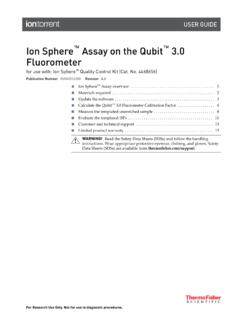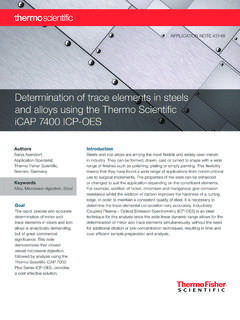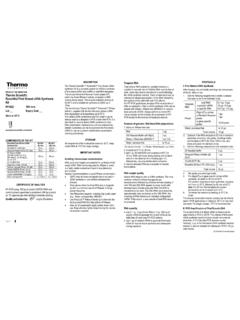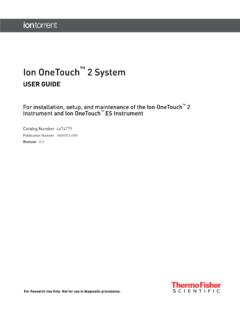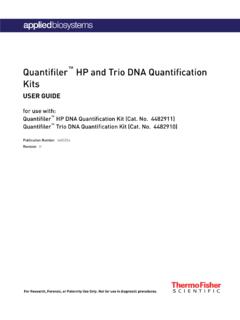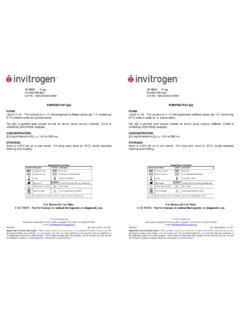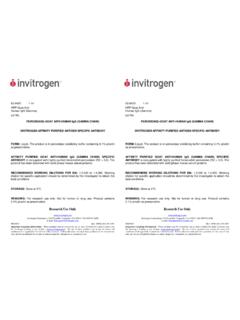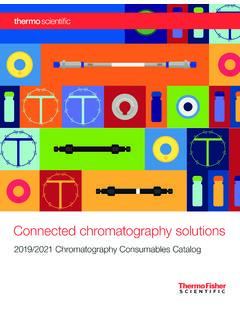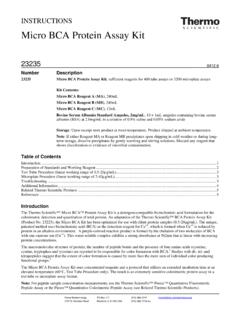Transcription of A theoretical and practical guide for spectrophotometric ...
1 TECHNICAL NOTE NanoDrop One/OneC and Multiskan Sky spectrophotometersA theoretical and practical guide for spectrophotometric determination of protein concentrations at 280 nmof a given protein is not strictly dependent on amino acid content but also on buffer type, ionic strength, and the pH of the protein solution. Different preparations of the same protein can be highly heterogeneous with respect to protein conformations and posttranslational modifications ( , oxidation, glycosylation), which can further affect protein absorptivity. The absorptivity coefficient, also known as the extinction coefficient ( ), can be established for any given protein. For each protein or peptide, the extinction coefficient can be experimentally determined or calculated from the amino acid sequence, based on the premise that the absorption of amino acids is additive.
2 In section 2 of this note, we discuss different aspects related to extinction coefficients that can help clarify their use in though it was first reported in the 1950s [1], quantitation of protein concentration using direct measurements of absorbance at 280 nm is still one of the most widely used biochemical assays for protein measurement. This success is arguably related to several aspects: this assay is the fastest of all protein quantitation assays, no reagents are needed, and no incubation or other preparation steps are involved. It can typically be run without preparing any special protein standards, and the protein sample can be further recovered, if needed, for downstream applications. Because of these advantages, this assay is often the first choice for quick estimation of protein concentrations.
3 Here we revisit the most important theoretical and practical aspects that are needed in order to successfully understand and perform this Basis for spectrophotometric quantitation of proteins at 280 nmDirect spectrophotometric determination of proteins can be done at either 280 nm or 205 nm. In this note, only measurement at 280 nm will be discussed. At this wavelength, the aromatic amino acids tryptophan (Trp) and tyrosine (Tyr) exhibit strong light absorption, and to a lesser extent cysteine groups forming disulfide bonds (Cys Cys) also absorb. Consequently, absorption of proteins and peptides at 280 nm is proportional to the content of these amino acids. However, the absorptivity Apart from their intrinsic absorptivity, proteins will absorb UV light in proportion to their concentrations.
4 This relationship has been exploited for the spectrophotometric determination of protein concentrations, and it is defined by the Beer Lambert law (or Beer s law). Beer s law describes the dependence of a protein s absorbance on its absorptivity coefficient, its concentration, and the pathlength of the incident light:The protein concentration based on the measured absorbance at 280 nm can be easily derived from the equation above:Despite its mathematical simplicity, the application of this equation can be difficult in some cases, especially when different extinction coefficients are available or different types of samples and volumes are used. In this note, we provide practical guidance on how to overcome these challenges (sections 2 4).2. Understanding and using extinction coefficients The most reliable extinction coefficient for any given protein is obviously one that can be experimentally measured using a known concentration of protein dissolved in the same buffer intended for the subsequent downstream applications.
5 However, several other estimation methods are quicker and still sufficiently accurate for determining protein concentrations for most laboratory applications. Currently these theoretical values are calculated with computing tools, and the only requisite or input needed is the primary sequence of the protein. Curated primary sequences of proteins, along with other functional information, are available in the Universal Protein Resource, known as UniProt ( ). For calculation of extinction coefficients, a popular and free solution is the ProtParam tool ( ) provided by the Swiss Institute of Bioinformatics. The ProtParam tool calculates the extinction coefficients utilizing the equation described above. The program generates two values for extinction coefficients.
6 The first value is calculated assuming all cysteine residues in the protein are forming disulfide bonds (C C), whereas the second value is calculated assuming all cysteine residues are in a reduced state, , no disulfide bonds are formed. This computation of extinction coefficients is quite reliable for tryptophan-containing proteins, but it is prone to errors for proteins that do not contain tryptophan coefficients of many different proteins have been compiled in the literature. For instance, they are reported in the practical Handbook of Biochemistry and Molecular Biology [3] as well as in specialized scientific journals. Most of the measurements reported in the literature have been performed in aqueous buffers, , phosphate, HEPES, or Tris-HCl buffers.
7 Thus, a value obtained with the protein dissolved in a buffer similar to that of the sample of interest can be selected. Hence, it can be concluded that extinction coefficient data, either predicted or experimental, are available for most proteins. A = cLwhere: A: absorbance of the sample (unitless) : molar extinction coefficient or molar absorptivity of the protein (M 1 cm 1)c: concentration of the protein (molar units, M)L: light pathlength (cm)Equation 1c = L A Equation 2 For example, the extinction coefficient at 280 nm of any protein in water can be theoretically estimated by the weighted sum of the 280 nm absorptivity coefficients of the three amino acids mentioned earlier [2]: = (nW x 5500) + (nY x 1490) + (nC x 125) where:W: tryptophanY: tyrosineC: cysteinen: number of each residue present in the protein 5500, 1490, and 125: molar absorptivity at 280 nm of W, Y, and C, respectivelyEquation 3 Table 1.
8 Examples of extinction coefficients for molar43623 M 1 cm 1[4,5] molar44300 M 1 cm 1[4,6] molar47790 M 1 cm 1 ProtParam tool (all reduced Cys residues) 1% [4,5] 1% [4,6] 0 .1% tool (all reduced Cys residues)When selecting values from the available data, extinction coefficients that have been determined experimentally are preferred; however, as explained above, the values can differ depending on the selected buffer as well as other factors. In general, ProtParam predictions made with reduced Cys residues can be used for most proteins. For BSA, a 1% value of (or 0 .1% value of ) at 280 nm is generally accepted. From the relationship between 1% and molar seen in Equation 4 and assuming a molecular weight (MW) of 66400 for BSA, the extinction coefficient of can be calculated to correspond to an molar of 44488 M 1 cm 1, which is close to the reports of Gill and von Hippel [4].
9 Because reporting of extinction coefficients has not been standardized in the literature, the calculation of protein concentrations may be somewhat challenging. For instance, absorbance values (A280) for a 1% protein solution ( 1% or 1 percent) or a solution ( 0 .1%) are frequently reported, instead of the molar extinction coefficients shown in equation 2. The most commonly reported definitions of molar and mass extinction coefficients are listed below: molar is the molar extinction coefficient or molar absorptivity of the protein, expressed as M 1 cm 1 1% is the mass extinction coefficient or the percent solution extinction coefficient (absorbance values at 280 nm) for a 1% or 10 mg/mL solution of a reference protein measured in a 1 cm cuvette, expressed as 10 (mg/mL) 1 (cm) 1 0.
10 1% is the mass extinction coefficient or the percent solution extinction coefficient (absorbance values at 280 nm for a or 1 mg/mL solution of a reference protein measured in a 1 cm cuvette; expressed as (mg/mL) 1 (cm) 1In the Beer s law equation (equation 1), the molar extinction coefficients are included ( molar) and the molar concentrations are obtained. Therefore, the molar concentration should be multiplied by the molecular weight of the protein to express the final protein concentration in mg/mL. In contrast, when using mass extinction coefficient values ( 1% or 0 .1%) in the Beer s law equation, the results are directly expressed as mass percentages of 1% (10 mg/mL) or (1 mg/mL). When using 1%, an adjustment factor of 10 needs to be applied to express the final protein concentrations in mg/mL.)
